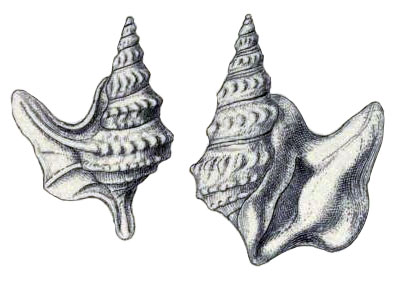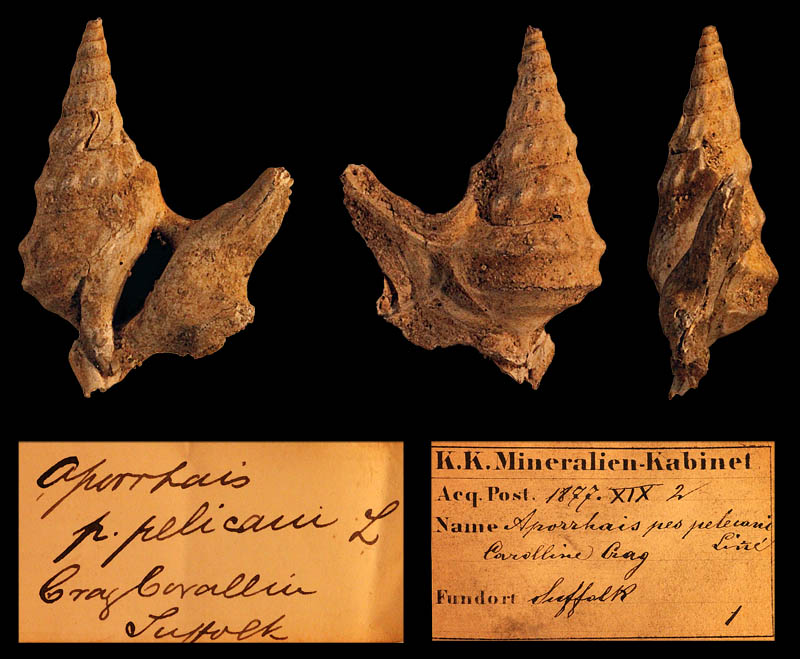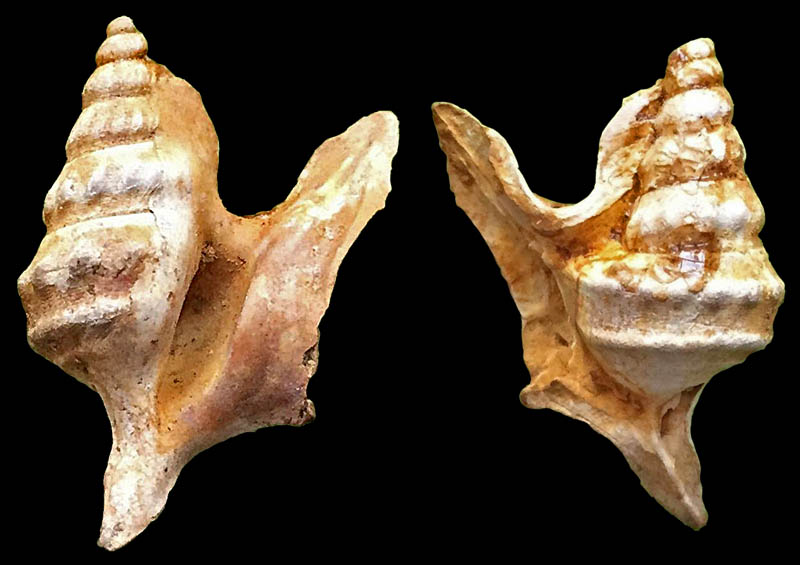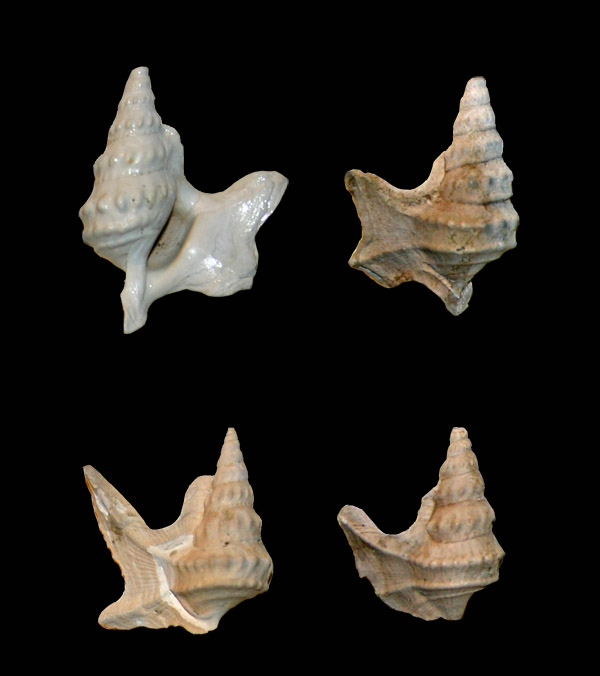|
edit SideBar
|
Species / Chenopus Anglicus
- Chenopus anglicus d'Orbigny, 1852
Original Description of Chenopus Anglicus by d'Orbigny, 1852, p. 59 (1031):
- "1031. Anglicus, d'Orb., 1847. Rostellaria pes-pelicani, Sow., 1837, Min. Conch., 6, p. 109, pl. 558, fig. 1. Nyst., pl. 43, fig. 7. Angleterre, Norfolk et Suffolk; Belgique, Anvers, Doel."
1835
Description of Rostellaria pes-pelicani by Nyst, 1835, p. 31:
- "No. 37. - Rostellaria pes-pelicani, Park. org. remai. 3, 63. Sow. min. conch. vol. 6, page 109, pl. 558, fig. 1. Car. sp. Coquille turriculée, striée, tours de spire anguleux dans eur milieu, le dernier tricosté, les côtes supérieures nodulées; lèvre dilatée en trois digitations pointues, divergentes; canal oblique à sa base, subfoliacé."
- "Localitées. Anvers; en Angleterre, dans le Crag de Suffolk; en Italie: en Toscane; dans le Piémont; en France, à Bordeaux; et vivante dans l'Océan européen, la Méditerranée, l'Adriatique et les mers des Indes."
1837
Description of Rostellaria pes-pelicani by Sowerby, 1837, p. 109:
- "Spec. Char. Turreted, striated; whorls angular in the middle and nodulose; last whorl three-keeled; the two upper keels divided into tubercles; lip expanded into three, pointed, diverging lobes; the canal at the base oblique, subfoliaceous."
- "Syn. Strombus Pes-Pelicani. Linn. et Auct. Brocchi, 2. 385. Rostellaria Pes-Pelicani. Parkinson's Organic Remains, 3. 63. Lamarck, Syst. 7. 193. Var. meridionalis. Basterot, Mém. de la Soc. d'Histoire Nat. de Paris, 2. 69."
- "The fossil shell now before us so precisely resembles the species well known as an inhabitant of the sea at the present day, that we can but consider them the same. Similar shells are found in the vicinity of Dax and in Placentia; but although they are referred to the same species, some differences may be observed which appear to be constant: - those found near Dax are smaller, and have more elongated but less prominent tubercles; those of Placentia have the angles upon the upper whorls, and the keels upon the last whorl, as Mons. Brongniart has justly observed, either smooth without any tubercle, or only furnished with projecting points. It may be doubted whether these and the R. Pes-Carbonis of Brongniart (Terrains du Vicentin, p. 75), which has no angles upon the upper whorls, but only elongated tubercles or costae, are not varieties of the same species, depending upon locality. We find much difference among specimens of the recent type from different places. In a clay pit at Tottenhill near Lynn in Norfolk, are great numbers of this fossil, as we learnt several years ago from Mr. Wales of Downham. We have also been supplied with specimens by Mr. Rose of Swaffham, who finds Turbo Terebra (Linn.) with them. Specimens have been found in Suffolk, in Crag, by the Rev. G.R. Leathes, of which we have represented one, but not perfect enough to show the three lobes of the lip. May it not have been such a one that Parkinson found in the Essex Cliff, since he describes it as having but one spur-like process? or did he find the London Clay species?"
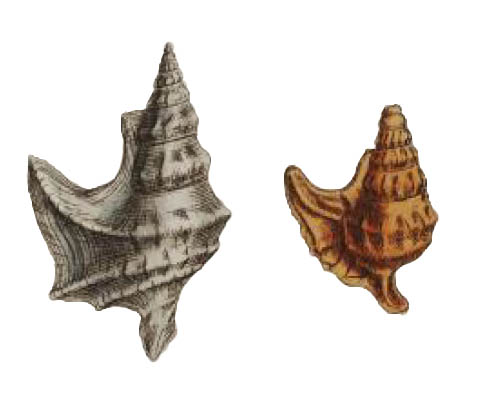 Rostellaria pes-pelicani in Sowerby, 1837, pl. 558, fig. 1
1848
Aporrhais pespelicani in Wood, 1848, pl. II, fig. 4 a, b
Wood, 1848, p. 25 about Aporrhais pes-pelicani:
- "Locality. Cor. Crag, Ramsholt and Gedgrave. Red Crag, Sutton, Newborn, Brightwell, and Bawdsey. Recent, British Seas."
- "This shell is rarely found in good condition in the Red Crag; some well-preserved specimens, however, show a perfect identity with the long known recent species. The middle of the volution is slightly angular and nodulous, so also is the prominent keel at the base of the whorl, like that of the recent shell, with another ridge beneath it. The striae are obliterated from all my Red Crag specimens, though shown in those from the Coralline. This is a living Mediterranean species, and stated by Philippi to be exceedingly variable there. My Crag specimens are very uniform in character."
1954
Van Regteren Altena, 1954, p. 48:
- "Discussion. - This [Aporrhais scaldensis] is the common Aporrhais from the Scaldisien-Poederlien of Antwerp. In the Institut Royal des Sciences Naturelles at Brussels I found that it occurs with a form of Aporrhais pespelicani (L.) which is at least very similar to the subspecies quadrifidus Da Costa. The new species has often been considered a small variety of A. pespelicani. In Brussels I could compare it with a series of A. pespelicani (L.) var. minor B.D.D. in the Dautzenberg collection. There appears to be hardly any difference in size, but scaldensis is a much more delicate shell, in which the knobs on the shoulder of the whorls of the spire are less coarse, closer together, and prolonged in an axial direction. In A. pespelicani these knobs do not tend to vanish on the second half of the last whorl. Harmer identified the present species with A. serresianus macandreae Jeffreys. That form has, however, a larger and more solid shell, with longer digitations of the outer lip of the aperture, and more pronounced knobs on the second half of the last whorl. Chenopus anglicus D'Orbigny, 1852, was based on an English specimen figured by J. Sowerby and a Belgian one figured by Nyst. The latter specimen seems to have belonged to the present form, and the former to A. pespelicani quadrifidus Da Costa. As far as I know no lectotype has ever been selected for Chenopus anglicus. In view of the specific name the specimen figured bij Sowerby is here selected as such."
Specimens from institutional collections
Aporrhais pespelicani (Linnaeus, 1758); Coralline Crag, Zanclean, lower Pliocene; Suffolk County, East Region, England; Coll. NHMW no. 1877/XIX/2
Specimens from private collections
Chenopus anglicus d'Orbigny, 1852; Coralline Crag, Zanclean, lower Pliocene; near Orford Castle, Suffolk County, East Region, England; 24,5mm; Coll. Philippe Simonet
In the Pliocene of the North Sea basin Aporrhais pespelecani is found. This was named by Marquet, 1998 Aporrhais pespelecani quadrifida
References
|


